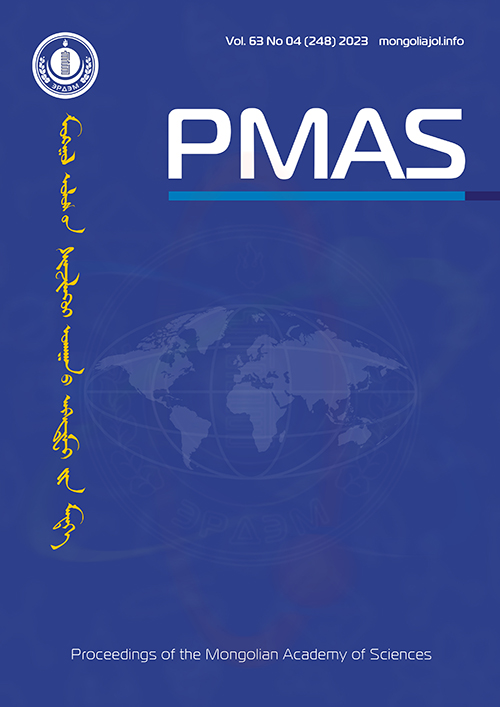Results of HDV RNA detection in male seminal fluid and female cervical swab samples using RT-PCR
DOI:
https://doi.org/10.5564/pmas.v63i04.3432Keywords:
HBV, HDV, Sexual transmission, Seminal fluidAbstract
Mongolia has an extremely high prevalence of hepatitis D virus (HDV), which leads to increased morbidity and mortality from hepatocellular carcinoma (HCC). HDV is the most severe form of chronic viral hepatitis (CVH). A recent study estimated that the prevalence of anti-HDV was 67.5% among hepatitis B surface antigen-positive cases in Mongolia. HDV infection is particularly prevalent in sexually active young people. The virus may be transmitted through sexual intercourse, and it is crucial to confirm this by detecting HDV RNA in semen and cervical swabs of patients with chronic hepatitis delta. This pilot study was conducted with 16 participants, including eight males and eight females. Viral RNA was isolated from the blood, male seminal fluid, and female cervical swab samples of all participants in the study. HDV RNA was quantified using RT-PCR in samples from blood, seminal fluid, and cervical swabs. This study found that the detection rate of HDV RNA differed between male and female samples, with 62.5% of seminal fluid samples in the male cohort being positive compared with 87.5% in the female cohort. The data shows a statistically significant difference between genders for the presence of HDVRNA in seminal fluid and cervical swabs (OR 0.238, 95% CI= 0.02-3.01). A significant correlation was found between blood HDV RNA quantity and HDV RNA presence status in seminal fluid and cervical swab samples, indicating a potential risk of sexual HDV transmission. The R2 values for semen and cervical swab samples were 0.1095 and 0.9755, respectively.
Downloads
338
References
Z. Miao et al., “Estimating the global prevalence, disease progression, and clinical outcome of hepatitis delta virus infection,” Journal of Infectious Diseases, vol. 221, no. 10, pp. 1677–1687, May 2020, https://doi.org/10.1093/infdis/jiz633.
L. F. Botelho-Souza, M. P. A. Vasconcelos, A. D. O. Dos Santos, J. M. V. Salcedo, and D. S. Vieira, “Hepatitis delta: Virological and clinical aspects,” Virology Journal, vol. 14, no. 1. BioMed Central Ltd., Sep. 13, 2017. https://doi.org/10.1186/s12985-017-0845-y.
B. Dashtseren et al., “Endemic prevalence of hepatitis B and C in Mongolia: A nationwide survey amongst Mongolian adults,” J Viral Hepat, vol. 24, no. 9, pp. 759–767, Sep. 2017, https://doi.org/10.1111/jvh.12697.
M. Rizzetto, “Hepatitis D (DELTA),” 2022.
J. Vlachogiannakos and G. V. Papatheodoridis, “New epidemiology of hepatitis delta,” Liver International, vol. 40, no. S1. Blackwell Publishing Ltd, pp. 48–53, Feb. 01, 2020. https://doi.org/10.1111/liv.14357.
A. Olivero and A. Smedile, “Hepatitis delta virus diagnosis,” Semin Liver Dis, vol. 32, no. 3, pp. 220–227, 2012,https://doi.org/10.1055/s-0032-1323627.
H. Salimnia, “Quantitative PCR: An Introduction,” 2010. doi: 10.1016/B978-0-12-369428-7.X0001-8.
P. Piot, C. Goilav, and E. Kegels, “Hepatitis B: transmission by sexual contact and needle sharing,” 1990,https://doi.org/10.1016/0264-410X(90)90215-8.
M. Szumilas, “Information Management for the Busy Practitioner Explaining Odds Ratios,” 2010. [Online]. Available: http://www.csm-oxford.org.uk/.
B. Dashtseren et al., “Endemic prevalence of hepatitis B and C in Mongolia: A nationwide survey amongst Mongolian adults,” J Viral Hepat, vol. 24, no. 9, pp. 759–767, Sep. 2017, https://doi.org/10.1111/jvh.12697.
H. Y. Chen et al., “Prevalence and burden of hepatitis D virus infection in the global population: A systematic review and meta-analysis,” Gut, vol. 68, no. 3, pp. 512–521, Mar. 2019, https://doi.org/10.1136/gutjnl-2018-316601.
X. Chen et al., “A novel quantitative microarray antibody capture assay identifies an extremely high hepatitis delta virus prevalence among hepatitis B virus–infected mongolians,” Hepatology, vol. 66, no. 6, pp. 1739–1749, Dec. 2017, https://doi.org/10.1002/hep.28957.
https://www.who.int/news-room/fact-sheets/detail/hepatitis-d.
J. C. Wu et al., “Sexual transmission of hepatitis D virus infection in Taiwan,” Hepatology, vol. 11, no. 6, pp. 1057–1061, 1990, https://doi.org/10.1002/hep.1840110623.
Y. F. Liaw, K.-W. Chiu, C.-M. Chu, I.-S. Sheen, and M.-J. Huang, “Heterosexual Transmission of Hepatitis Delta Virus in the General Population of an Area Endemic for Hepatitis B Virus Infection: A Prospective Study Downloaded from,” 1990, https://doi.org/10.1093/infdis/162.5.1170.
L. Rosenblum et al., “Sexual Practices in the Transmission of Hepatitis B Virus and Prevalence of Hepatitis Delta Virus Infection in Female Prostitutes in the United States Our data support guidelines that recommend hepatitis B vaccination for prostitutes and persons with a history of sexually transmitted diseases or multiple sexual part.” [Online]. Available: http://jama.jamanetwork.com/.
C. Chen, I. Sheen, S. Lee, H. Tzeng, and K. Choo, “From the Division of Gastroenterology, Departments of Medicine and Medical Research, Veterans General Hospital,” 1995.
W. Mansour et al., “Markers of hepatitis delta virus infection can be detected in follicular fluid and semen,” Journal of Clinical Virology, vol. 61, no. 2, pp. 279–281, 2014, https://doi.org/10.1016/j.jcv.2014.06.029.
C. Osiowy et al., “Transmission of hepatitis D virus between spouses: A longitudinal study of the first reported Canadian case,” IDCases, vol. 8, pp. 37–41, 2017, https://doi.org/10.1016/j.idcr.2017.03.001
Downloads
Published
How to Cite
Issue
Section
License
Copyright (c) 2024 Saruul Enkhjargal, Oyungerel Lkhagva-Ochir, Anir Enkhbat, Naranjargal Dashdorj, Nyamtsengel `Vangan, Odgerel Oidovsambuu

This work is licensed under a Creative Commons Attribution 4.0 International License.
Copyright on any research article in the Proceedings of the Mongolian Academy of Sciences is retained by the author(s).
The authors grant the Proceedings of the Mongolian Academy of Sciences a license to publish the article and identify itself as the original publisher.

Articles in the Proceedings of the Mongolian Academy of Sciences are Open Access articles published under a Creative Commons Attribution 4.0 International License CC BY.
This license permits use, distribution and reproduction in any medium, provided the original work is properly cited.

